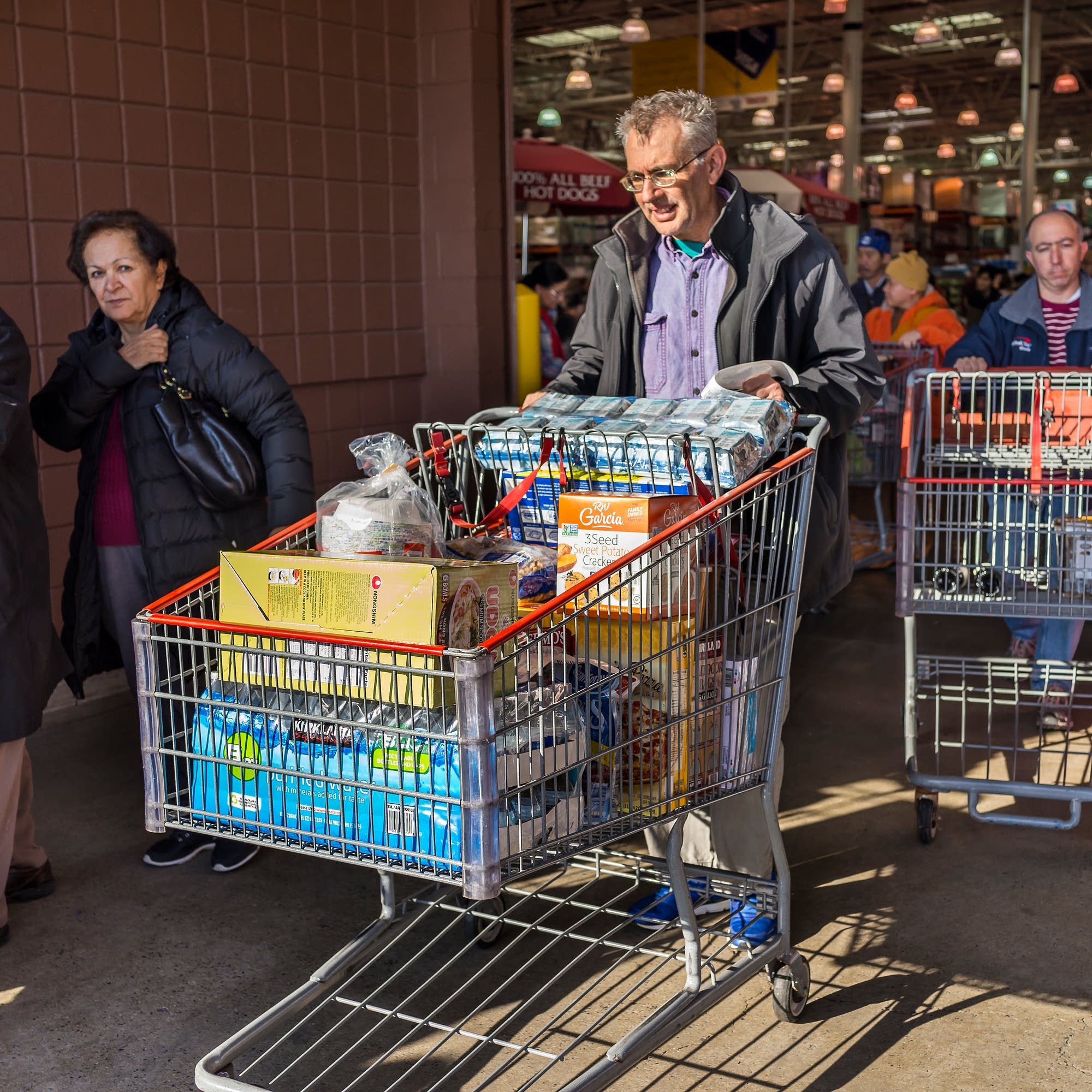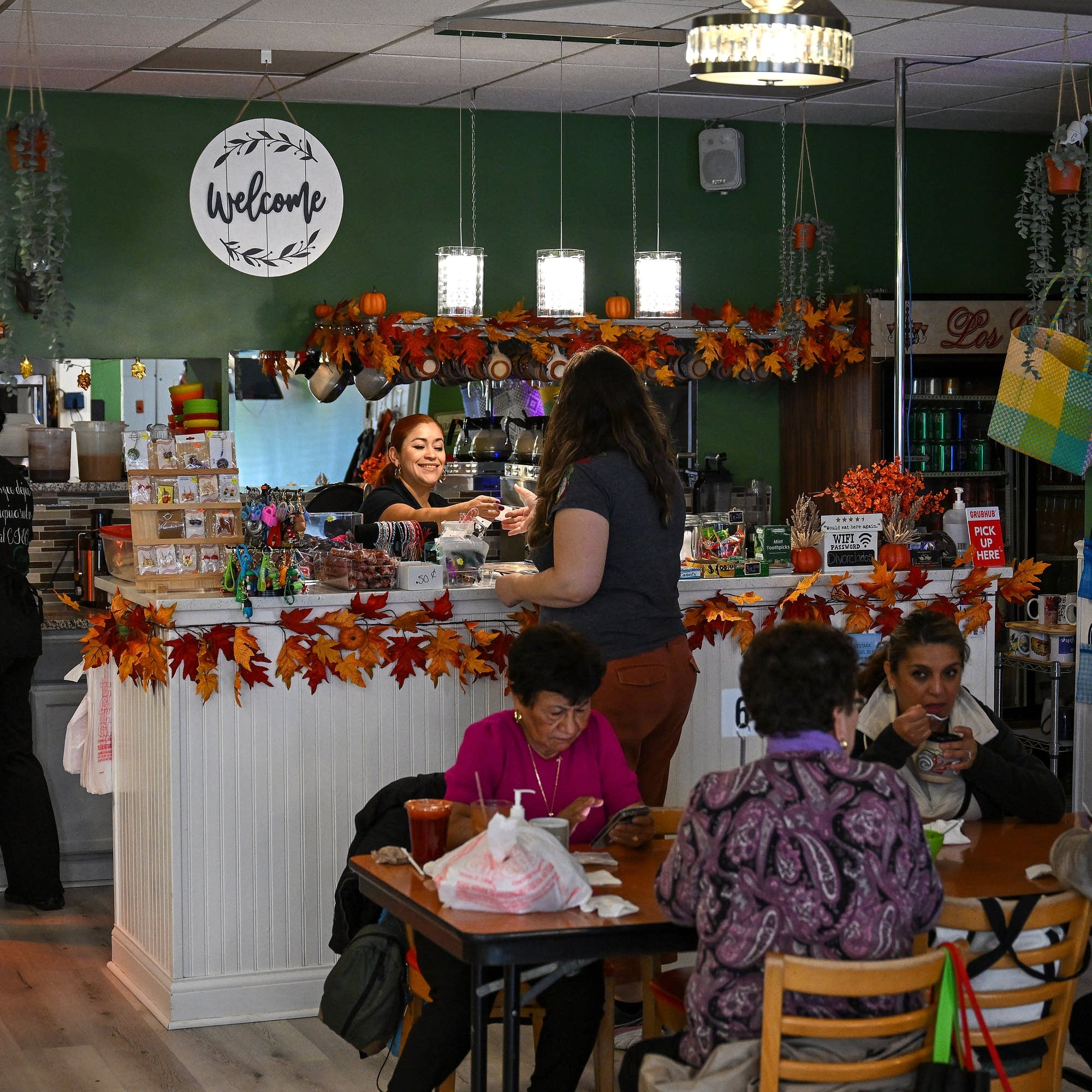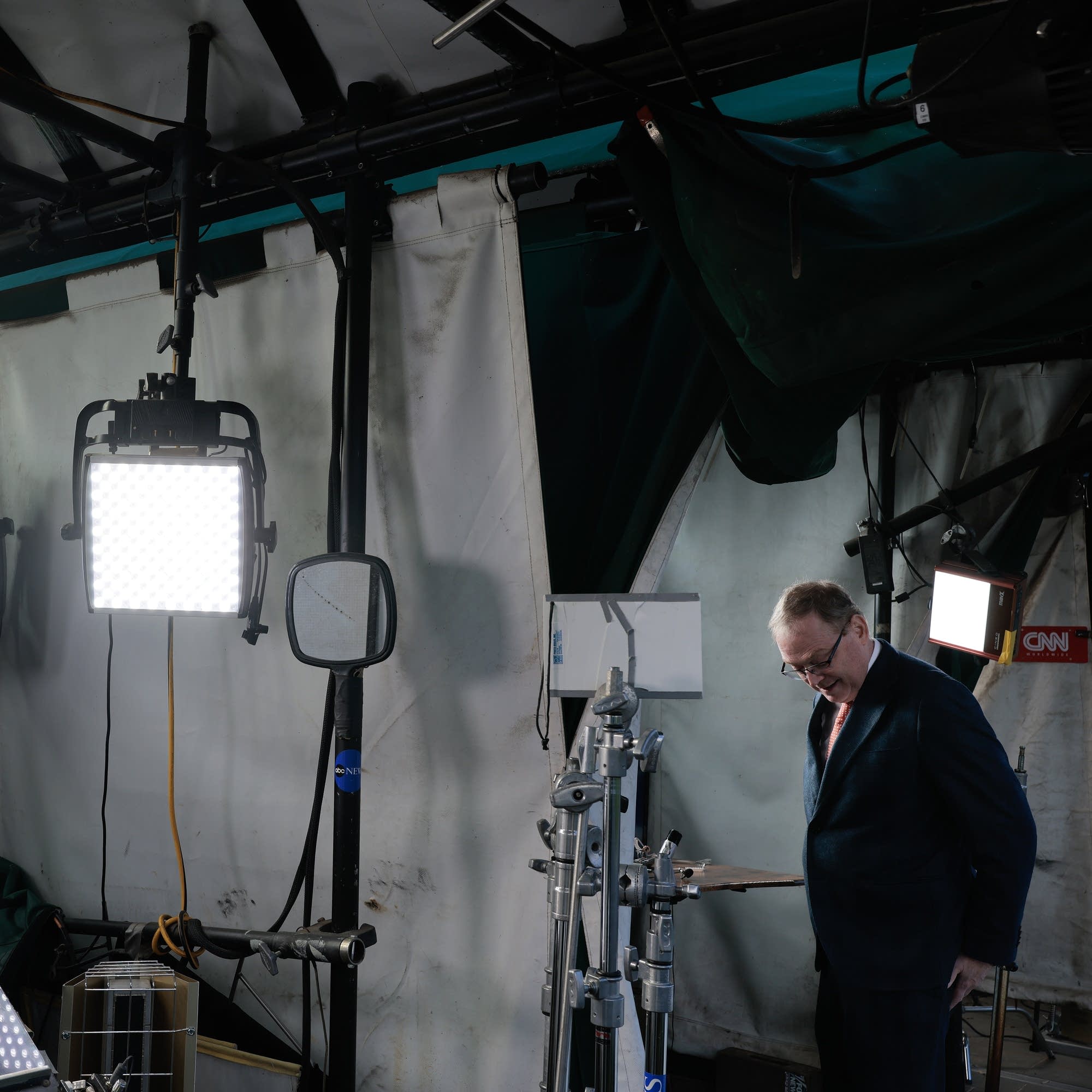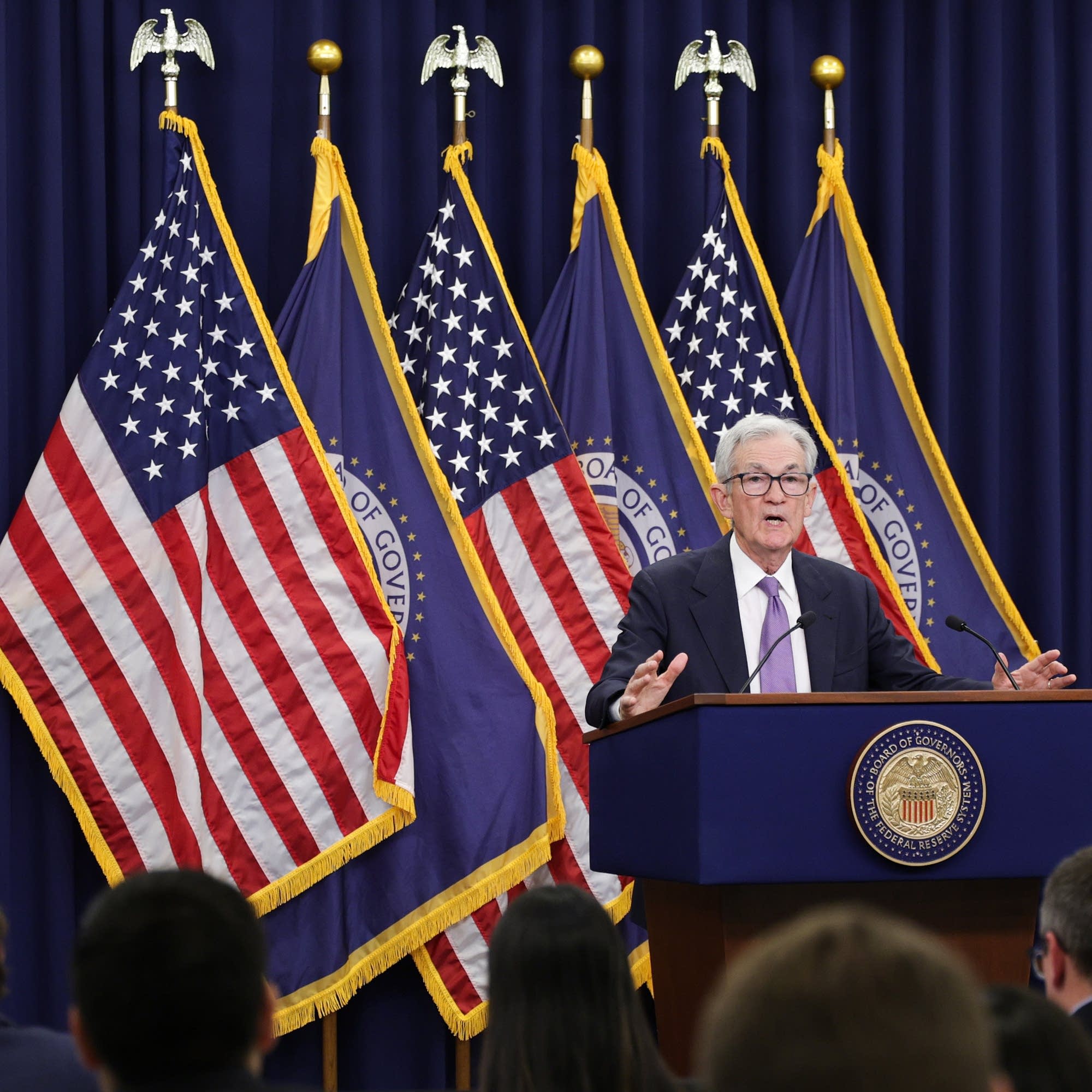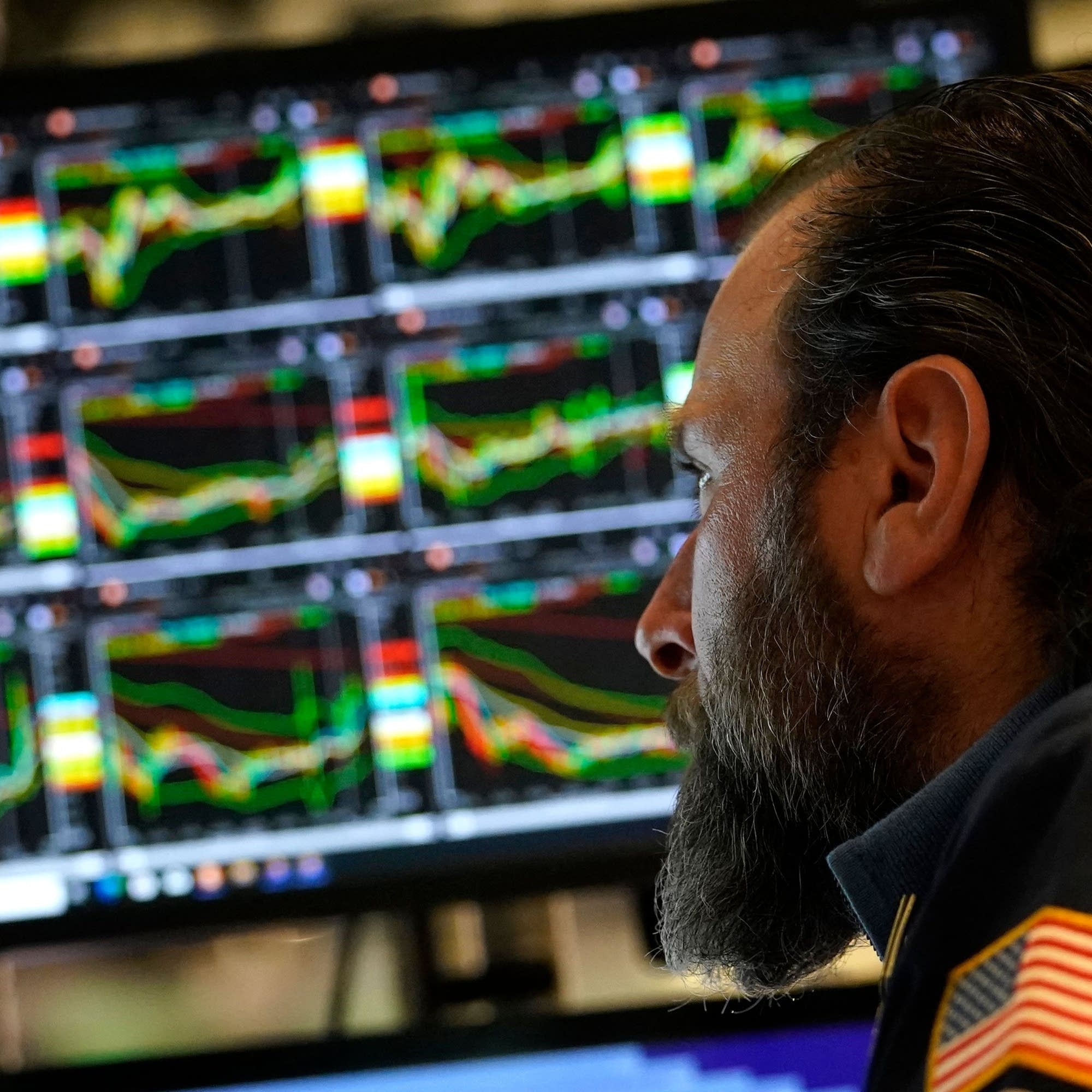Not everyone’s stretching the dollar the same way
Consumers everywhere are trying to stretch their dollars to compensate for economic uncertainty and inflation. However, there’s a divide between higher and lower earners. In this episode, we look at how people across the economic spectrum are trying to get more bang for their buck. Plus, one recent college graduate’s decision to leave the U.S. for job prospects abroad, commodity shortages mean less chocolate in your Halloween candy, and a weekly wrap-up of the latest economic headlines.
Every story has an economic angle. Want some in your inbox? Subscribe to our daily or weekly newsletter.
Marketplace is more than a radio show. Check out our original reporting and financial literacy content at marketplace.org — and consider making an investment in our future.
Press play and read along
Transcript
marketplace podcast is supported by U.com. U.com is AI search infrastructure for the enterprise.
We provide the building blocks for AI to reason, decide, and act with the accuracy of industry experts.
Our LLM agnostic modular infrastructure combines composable agents and APIs with enterprise-grade accuracy, trust, and flexibility, empowering organizations to connect public, private, and third-party data into secure, production-ready workflows.
YOU.com/slash marketplace.
This podcast is supported by Odo. Some say Odo business management software is like fertilizer for businesses because the simple, efficient software promotes growth.
Others say Odoo is like a magic beanstalk because it scales with you and is magically affordable.
And some describe Odo's programs for manufacturing, accounting, and more as building blocks for creating a custom software suite. So Odo is fertilizer, magic beanstock building blocks for business.
Odo, exactly what businesses need. Sign up at odoo.com.
That's odoo.com.
Finally, some economic data from a still shutdown government, but better late than nothing, I guess. From American Public Media, this is Marketplace.
In Washington, I'm Kimberly Adams in for Chi Rizdahl. It is Friday, October 24th.
Good to have you along. We are on day 24 of of the federal shutdown, already the second longest on record.
And today, more than a million federal workers missed their first full paycheck after getting a short check two weeks ago.
Another consequence of the shutdown has been the drought in federal economic data releases until today.
This morning, we got the delayed September Consumer Price Index Report from the Bureau of Labor Statistics, showing inflation is up 3% year over year.
For more on this and other economic news of the week, we've got David Gurra at Bloomberg and Rachel Siegel at The Washington Post. Hey, you two.
Hey. Hey there.
Rachel, why are we getting
CPI data and not some of the other important releases like the jobs numbers, for example?
Yeah, so you'll remember that this is a CPI report originally slated to come out a couple of weeks ago on the 15th, but that was postponed because of the ongoing shutdown.
But now we're at the point where the White House had to recall some key employees, not just to finish this report, but also calculate the annual cost of living adjustments for Social Security recipients.
So we're getting to the point where there's information that has to come out. And with it, we're getting some delayed figures, which are really key because things keep marching on, right?
We're headed towards a Fed meeting. We're all trying to understand what's going on in the economy.
So data better delayed than never.
Yeah, so let's try to understand what's going on in the economy based on the data that we do have. David,
report showed month-over-month month inflation, not quite as bad as a lot of people expected, especially given the tariffs. What's going on there?
Yeah, I think you could call it cooler or softer. I'll let you pick the descriptor that you want to use there, but certainly these numbers were better than Wall Street expected.
And to pick up on what Rachel was saying just a moment ago, I mean, the Fed was looking forward to getting these data before the meeting next week.
I think they probably have more consequence about the meeting after this one. It was kind of all but guaranteed the Fed's going to lower rates again at this meeting next next week.
But yeah, but you look at kind of where we've seen
increases in prices. You see kind of tariffs weighing a bit on core goods prices.
So those are prices that kind of exclude energy and food, the most volatile parts of the CPI basket.
We did see prices go up on furniture, on clothing.
Some services prices went up as well.
You know, I'm very curious sort of what happens from this point on. Again, Rachel's saying that we're, you know, the economy marches on.
Delayed data is better than none.
We did get notice from the White House today that this is likely to be the last raft of data that we get, certainly on inflation, CPI data from the Labor Department, just because while they were able to bring those workers back to go through that data and present these data today,
they're not actively collecting it.
So it raises just a host of questions about sort of what visibility we have into the economy, this part of the economy going forward, if that collection isn't taking place.
You know, at the same time, Rachel, the year-over-year inflation, like we said at the top, is at about 3%, which is still higher than the Fed's 2% target.
So what does that mean for their meeting next week, especially given that last time they were talking all about shifting the focus to jobs?
Yeah, I mean, I feel like you just got it the key question that's going to come before Chair Powell next week. You know, 3% is not 2%.
It's actually quite a bit a ways from 2%.
And that is made all the more complicated at a time where there are lingering concerns about the job market, that the Fed itself is trying to preempt any more softening in the job market.
And this is where you hear about Jay Powell talk about these points of their mandate that are really intentioned. You've got a softening job market on one end and inflation that is not increasingly
landing at a more comfortable place.
It's still possible, I think, that the Fed continues to cut even at a slower pace, but they're going to have to continue to answer for why they can cut rates when inflation is not just getting closer and closer and closer to 2%, but in some cases, still staying really vulnerable to all these other factors, tariffs among them.
And And David, I was watching your Bloomberg this morning talking about the K-shaped economy and the fact that this still isn't being felt equally, the inflation that we do have, the job losses that we do have.
How do you think the Fed's going to try to navigate that?
I mean, that's been something kind of front of mind for them for a long time now, but you're right, that's still being shown in stark relief that there are people who are and have been really suffering as a result of prices going up.
And then there's kind of another echelon of people who are better off, making more money, are able to kind of weather the increases that we've we've seen thus far.
You listen to Jay Powell and other policymakers, and they talk about how they look at the economy holistically.
They're cognizant of the fact that this is, inflation is a real burden on a large swath of the population. But
I'm sorry to dodge the question here a little bit.
I think it is like a crucial and difficult part of their job here is figuring out how to make sure that the changes and policies they're putting in place here result in policies that are equitable across the economy.
I want to shift to talking about trade for a bit because we had a lot of news on that front this week with new Russia sanctions, the pause on trade talks with Canada because of an ad.
And now the president is headed to Asia this weekend for more trade talks. You know, it feels like trade policy has been so all over the place with this administration.
Rachel, what do you think is next for the president and the economy in this arena?
Oh, gosh, if I knew the answer to that, I feel like
I would know so many things about the future. I mean, I think it all underscores, right? You know, this is not anything new, but what you're getting at can change with a tweet.
It can change with a TV ad. There are some milestones, right, that I think a lot of people are looking forward to.
We have an upcoming meeting with Scott Besant and Jameson Greer with the Chinese vice premier ahead of a much anticipated meeting with Trump NG.
And I think it's completely fair to latch on to that for some sort of certainty as to what will be going on with a enormous trade, you know, open question.
But then again, keep your Trump truth social alerts on, you know, because these things can change so quickly.
And that obviously has really tangible impacts that, you know, aren't as lighthearted for any business or household just trying to understand how to place their orders, how to budget for the coming month.
And these are all things that touch really close to home, even when they play out in these really big, sweeping, sort of hard-to-grasp zones.
David, this Asia trip in particular, what are you looking for in terms of outcomes, you know, in sort of the ideal policy world?
Yeah, I mean, I think the big thing we're looking for is: does this meeting take place between President Trump and President Xi, and what, if anything, comes out of that?
But, you know, I think that the best case here is there are some meetings between President Trump and other world leaders where each emerges with a better sense of what's going on here.
You know, I heard one of the president's trade advisors speaking last week and just kind of wondered if he would be able to list sort of what all the stack tariffs on china are at this point in time i mean we we just had like so many changes and so many additions and yes every now and then some are subtracted but there's just so much confusion swirling around what the policy is what's in place what's likely to happen i think any clarity that we can get as a result of these face-to-face meetings would be hugely helpful but again the mercurial nature of all of this is confounding for reporters certainly confounding for policymakers and for politicians as well I think that's likely to continue.
You can count me among the kind of maybe not pessimistic, but cautiously optimistic we get some clarity out of this.
But again, I think the real thing to watch here is just sort of who meets with whom and what, if anything, comes out of that.
And if we get clarity, we will be lucky. David Gura at Bloomberg, Rachel Siegel at the Washington Post.
Thanks so much. Thank you.
Thanks so much. Take care.
On Wall Street today, traders liked that inflation report and sent the markets to a new record high. We'll have the details when we do the numbers.
In other data news, the consumer products giant Procter Gamble reported earnings this morning. A solid quarter with nearly $5 billion in profits.
And the way PNG is making money highlights that trend that we were were just talking about, the K-shaped economy, where wealthy households are making up a larger and larger share of spending and lower-income households are falling behind.
And as Marketplace's Matt Levin reports, that's playing out in the market for everyday household items.
With sticky inflation in a worsening job market, high-income and low-income consumers want the same thing, to stretch their dollar as much as possible.
It's just that richer households can stretch their dollar over one of those giant detergent containers with like 70,000 Tide Pods in them. Peter Galbo is an analyst at Bank of America.
If you're a higher income consumer and you have the cash flow to be able to go to Costco and afford a $500 checkout bill, maybe that lasts you over two to three months.
Galbo says more high-income households are buying in bulk at Costco or Amazon or Sam's Club.
Meanwhile, if you're living paycheck to paycheck, you're trying to put put off the Target or Walmart or dollar store run for as long as possible.
It could be you're using less liquid in each load of laundry. Maybe you're shoving more clothes in the washer.
Consumer staple brands have been coming up with innovative ways to make sure none of their product gets wasted. Take paper towels.
Olivia Tong is an analyst at Raymond James.
Where it used to be one size and now you can, now they're half sizes, right? And I think some even do like a quarter sizes. You know, the consumer has more choice.
It's not just the bottom of the income ladder that's squeezing toothpaste to the last drop and searching for white label alternatives to brand names. Allie Furman analyzes consumer markets at PwC.
The chasm is getting a lot closer between middle income and low income. The lines are starting to blur.
Even if you're middle income, you probably can't afford a house big enough to store stuff from Costco anyway. I'm Matt Levin for Marketplace.
Despite the CPI coming out this morning, we are still missing a lot of government data, including the jobs report.
But back in the summer, the Fed released some numbers on how young workers are doing, reporting that in June June of this year, workers aged 22 to 27 had a 7.1% unemployment rate, the highest it's been since March of 2022.
It is not easy out there for young workers, which brings us to the next installment of our series, My Economy. Hi, my name is Amy Resnick.
I'm from Centennial, Colorado, and I will be moving to South Korea to teach English at the end of this year.
I just graduated with a degree in social policy from Northwestern University, and I've known I've wanted to work in government for a very long time.
The first role I had in government was at age 12, and since then, I've just known I want to make a difference in the state of Colorado as a public servant.
So when I heard that the state of Colorado was implementing a hiring freeze, that was devastating to my job search.
I looked for a job for a very long time, but I wasn't receiving a very good response, and I was kind of surprised, just not in an entitled way, but because I felt like I had had done all the things a recent college graduate could do in terms of having work experience and doing clubs and being involved and being passionate so I felt somewhat surprised that I wasn't even able to get one job out of hundreds of applications you know because you just need one
One of my very good friends is from China and he encouraged me to start applying for jobs in China. And at first I didn't want to do that.
I felt like I wanted to stay in the US and work in government administration and make a a difference here.
But as my job search just kept getting longer and longer, I started considering his idea more seriously.
So I got a certification to teach English as a foreign language and I found a position in less than a month.
I've accepted a role in Chiang Won, South Korea to teach business English to adult employees of a corporation.
I'm really excited to live by the water, take my dog for walks on the beach and make new friends. I'm trying to learn the language and I will.
I will learn the language, but it is very difficult.
Overall, I'm really excited to be able to try a new field that I think is potentially more stable than government administration.
The political instability and the instability of finding a job in government is what's preventing me from feeling optimistic that I'll return to the United States and get a job in public administration.
And as someone who felt really passionate about working for the state of Colorado and making a difference to the citizens of the state of Colorado, It was so incredibly disappointing to know I would not be able to realize that dream.
Even though that required a little bit of a mental pivot, I'm excited to maybe start a new career in international education that would take me outside the U.S.
and be more employable than something that's just confined to the United States economy, like government.
That was Amy Resnick in Centennial, Colorado, and soon in South Korea. If you have a story to share, go to marketplace.org slash myeconomy.
Coming up. I hate to admit it, I did like the green kit caps.
No shame in that. But first, let's do the numbers.
Record high closings for the three major indices today. The Dow Jones Industrial Average sprang up 472 points, 1%, to close at 47,207.
The NASDAQ climbed 263 points, 1.110%,
to finish at 23,204.
And the SP 500 jumped 53 points, 8 tenths percent, to end at 6,791. For the week, the Dow gained 2 2 10ths percent, the NASDAQ added 2.3%,
and the SP 500 increased 1 and 9 tenths percent.
Like Rachel mentioned up top, the Social Security Administration today announced a 2.8% increase in benefits next year, affecting about 75 million Americans.
Bonds rose, the yield on the 10-year T-note fell to 4.00%, and you're listening to Marketplace.
This podcast is brought to you by Wise, the app for international people using money around the globe.
With WISE, you can send, spend, and receive up to 40 currencies with only a few simple taps and save up to 55% compared to major banks.
Whether you're buying souvenirs with pesos in Puerto Vallarta or sending Euros to a loved one in Paris, you know you're getting a fair exchange rate with no extra markups.
That's what makes WISE the fast, affordable way to use your money around the globe.
WISE offers 24-7 live support and runs over 7 million daily checks to catch and prevent fraud, so you know your money is where it's supposed to be. Be smart.
Join the 15 million customers who choose WISE. Download the WISE app today or visit wise.com.
Learn more by visiting wise.com/slash US/slash compare. T's and C's apply.
This podcast is brought to you by LHH, the Global Talent Solutions and Advisory Company. What does work really mean? For many, it's just transactional, functional.
But LHH believes it can be more.
Work isn't just about tasks and deadlines. It's about passion, people, and possibilities.
With the right guidance and vision, incredible things can happen at work.
Finding the perfect hire, nurturing talent, making the ordinary extraordinary. LHH doesn't just find beautiful moments at work.
LHH creates them. Recruitment, development, career transition.
LHH, a beautiful working world. Learn more at LHH.com/slash beautiful.
This marketplace podcast is supported by Justin Wine. Get the celebration ready with Justin Wine.
Since 1981, Justin has been producing world-class Bordeaux-style wines from Paso Robles on California's Central Coast.
Justin offers curated gift sets, library wines, magnums, and even custom-etched bottles. Visit JustinWine.com and enter Market 20 for 20% off your order.
Justin offers the perfect holiday gifts for clients, colleagues, friends, or family. Be sure to check them out at justinwine.com to receive 20% off your order for a limited time.
This is Marketplace. I'm Kimberly Adams.
We've talked a lot on this show about severe weather causing a spike in insurance premiums across the country.
After the Palisades fire in California and recent hurricanes in Florida, premiums for homeowners in those states could increase by more than 30%.
And that's if those homeowners can get coverage. Many private insurance companies are leaving the market, and the issue isn't limited to coastal states.
From Southeast Missouri, Harshan Rattenpaul has more.
25 years ago, when Jason Ginder started selling insurance for the Missouri Farm Bureau, adding earthquake protection to his clients' coverage wasn't even a question.
The rates were so low, I didn't even ask people, I just put it on their policy. In the year 2000, more than 60% of homes around New Madrid, Missouri had earthquake insurance, but now it's only 10%.
Plus, the average cost of earthquake premiums went from $57 a year to $569 a year. The last major earthquakes in this region were way back in 1811 and 12.
So why are premiums today so much higher?
It probably is just due to risk. Earthquake risk has traditionally been hard to predict in areas where they don't hit that often.
But the thing that caused this spike in premiums is a change in how insurance companies model that risk. The models used by insurance companies, the statistical models, have become more reliable.
That's Michael R. Powers, a retired professor from Tsinghua University who studied the international insurance market.
They found that
they have to be more cautious. The models have improved because of better seismology equipment and clearer satellite imagery.
And in Missouri, the risk of a major earthquake was up to 7 to 10% in the next 50 years.
With new data, insurance companies raise prices to make sure they have enough money in reserves to pay out claims if or when an earthquake happens.
That can trigger a feedback loop when the price of insurance goes up. Economist Hong Lee studies insurance at the University of Guelph in Canada.
Some customers, they will say, oh,
I don't want this anymore. It's too expensive.
Lee says those customers tend to have the least need for insurance.
Maybe they think their house is sturdy, so the high cost of premiums isn't worth it to them.
When those homeowners drop out, the insurance pool has a higher proportion of risky properties, and companies bring in less profit to buffer against higher future payouts.
So insurance providers become even more risk-averse. You have to update your model, you update your reserve, you update everything, and then you further increase the price.
Which leads to homeowners dropping their policy, and and the loop starts again. Premiums rise, homeowners drop coverage, prices rise again.
That's why it's a spiral.
Now, there are ways the government could step in.
For example, most states have an insurer of last resort program that provides coverage for residents who struggle to get insurance on the private market.
That coverage can still cost homeowners tens of thousands of dollars. Missouri has a program like that for home, farm, and sinkhole protection, but not for earthquakes.
There's just not any urgency.
Former New Madrid state legislator Donnie Brown says there is a perception that coverage is unnecessary. Well, we haven't had a big one in 200 plus years, so
you know, maybe that's never going to happen. I think that's just, it's kind of out of sight, out of mind with people.
Still, even in places where disaster risk is obvious and hurricanes or wildfires are common, the insurance market is on shaky ground. And it will only get worse if more homeowners drop coverage.
In Southeast Missouri, I'm harsh on Rattenbaul for Marketplace.
Halloween is coming up, and even those of us not trick-or-treating might be inclined to scan for the new treats on offer.
Yasmin Tayeg of the Atlantic was doing that recently and noticed something seemed off in the candy aisle. Yasmin, welcome to the show.
Thanks so much for having me.
So what's going on with Halloween candy this year? You know, on first glance, the chocolates seemed pretty normal, you know, a lot of fun, new Halloween flavors.
But when I took a closer look, I noticed that chocolate candies that typically have a lot of chocolate in them, such as Kit Katz, Hershey's Nuggets, M ⁇ Ms,
didn't actually have that much chocolate, or in some cases, cases, none at all. In place of the chocolate, I saw things like a green marshmallow cream-flavored coating on a Kit Kat.
And the Hershey's Nuggets, likewise, are usually full of chocolate, but in this case, contained a pumpkin spice latte-flavored cream.
And what's behind that?
Well, I remembered all of the reporting I had been doing on the global cocoa shortage.
So this has been going on for a few years now, and it's really driven up the price of chocolate, which means that candy manufacturers that typically produce cheap chocolate can't really do so cheaply anymore.
They're having to spend more in order to make their products. And so one way of getting around that is to use less chocolate in the candies.
And that is what we're seeing in our Halloween candies this year. Yeah, it sounds like they're putting everything but chocolate in there.
I mean, is this stuff any good? I hate to admit it.
I did like the green Kit Kats.
And, you know, there was also, there was a cinnamon toast cream Kit Kat that was orange.
And they weren't chocolate, but they satisfied my sweetness craving, which is really all that cheap chocolate ever does anyway. It's not like
in ordinary times that they contain all that much cocoa to begin with. Now they contain even less, but they're still delivering on the immense dose of sweetness and the fun of novelty.
I imagine these companies can only reduce the amount of chocolate in chocolate so much, and there are larger systemic issues at play here that means this cocoa shortage might still be with us for a while.
Yeah, companies are really having to grapple with the idea that the chocolate supply may be unstable for a long time.
The decreasing cocoa supply is due to issues such as climate change, political issues, lack of infrastructure in the cocoa farming areas.
And those those issues don't seem to be getting fixed anytime soon. And so the companies can deal with this in two ways.
One is to use less chocolate and they can do that by changing the flavors or just making smaller chocolates, which we are seeing, or by pushing other candies that don't contain any chocolate.
And this is something we've been seeing quite a bit in the past few years. You're seeing companies really pushing fruity, gummy candies.
You know, one of the biggest brands right now is Shackalicious Gummies, which are fruity gummies made in the shape of Shaquille O'Neal's face.
But you're also seeing Sour Patch Kids, the resurgence of gushers, nerds, gummy clusters.
And
while an average consumer might look at this and think, ooh, fun new candies, the reality is that a lot of it is being driven by a lack of chocolate. What about you?
Are you more of a gummy person or a chocolate person? Oh, I'm a chocolate person, unfortunately, so I take this cocoa shortage very personally.
But in my reporting, I have learned that it's the really fine chocolates that are really going to suffer because they contain a lot of actual cocoa. For Halloween, I have much lower standards.
And if the future means green marshmallow Kit Katz, I think I'm okay with that. Yasmin Tayag is a staff writer for The Atlantic.
Thanks so much. Thanks so much for having me.
This final note on the way out today: chocolate isn't the only scarce commodity for Halloween this year.
As the Wall Street Journal reports, many parents are scrambling to find costumes or even components of costumes for kids wanting to dress up as characters from Netflix's hit animated movie, K-pop Demon Hunters.
The film was a surprise hit, so there weren't the advanced partnerships for official merch-like Halloween costumes. Parents, better break out those sewing skills.
It's your moment.
Our theme music was composed by BJ Lederman. Marketplace's executive producer is Nancy Fargali.
Joanne Griffith is the chief content officer.
Neil Scarborough is the vice president and general manager. And I'm Kimberly Adams.
Have a great weekend, everyone. We will be back on Monday.
This is APM.
Hey, everyone, it's Bridget, host of Million Bazillion, a podcast for Marketplace.
You've probably heard about the government shutdown, but if you're anything like our young caller Esme, whose dad is a federal worker, you might still have questions.
I've noticed that my dad hasn't been going to work, and I don't know when the government shutdown will stop, and my dad can go back to work. We can help.
Tune into our recent episode where we explain what you and the young ones in your life need to know about government shutdowns. Listen to Million Bazillion on your favorite podcast app.
